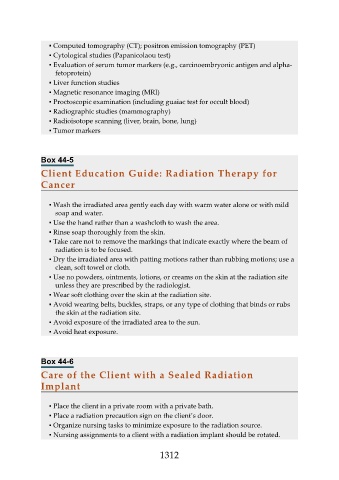Page 1312 - Saunders Comprehensive Review For NCLEX-RN
P. 1312
▪ Computed tomography (CT); positron emission tomography (PET)
▪ Cytological studies (Papanicolaou test)
▪ Evaluation of serum tumor markers (e.g., carcinoembryonic antigen and alpha-
fetoprotein)
▪ Liver function studies
▪ Magnetic resonance imaging (MRI)
▪ Proctoscopic examination (including guaiac test for occult blood)
▪ Radiographic studies (mammography)
▪ Radioisotope scanning (liver, brain, bone, lung)
▪ Tumor markers
Box 44-5
Client Education Guide: Radiation Therapy for
Cancer
▪ Wash the irradiated area gently each day with warm water alone or with mild
soap and water.
▪ Use the hand rather than a washcloth to wash the area.
▪ Rinse soap thoroughly from the skin.
▪ Take care not to remove the markings that indicate exactly where the beam of
radiation is to be focused.
▪ Dry the irradiated area with patting motions rather than rubbing motions; use a
clean, soft towel or cloth.
▪ Use no powders, ointments, lotions, or creams on the skin at the radiation site
unless they are prescribed by the radiologist.
▪ Wear soft clothing over the skin at the radiation site.
▪ Avoid wearing belts, buckles, straps, or any type of clothing that binds or rubs
the skin at the radiation site.
▪ Avoid exposure of the irradiated area to the sun.
▪ Avoid heat exposure.
Box 44-6
Care of the Client with a Sealed Radiation
Implant
▪ Place the client in a private room with a private bath.
▪ Place a radiation precaution sign on the client’s door.
▪ Organize nursing tasks to minimize exposure to the radiation source.
▪ Nursing assignments to a client with a radiation implant should be rotated.
1312

